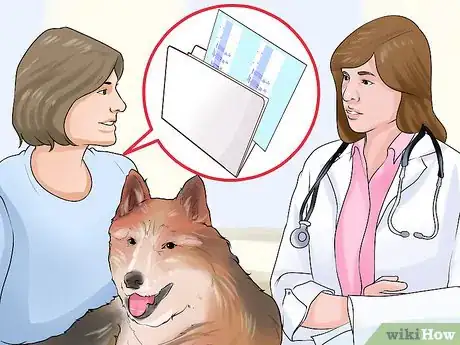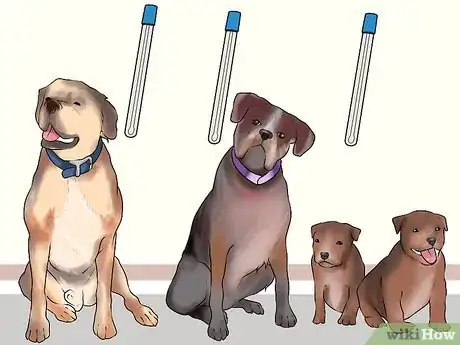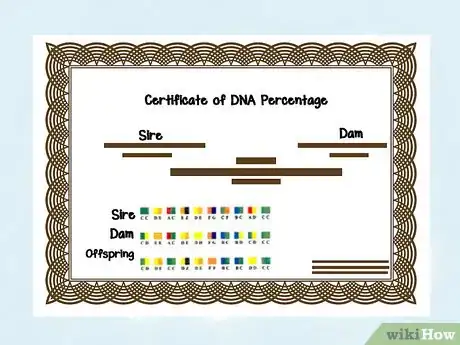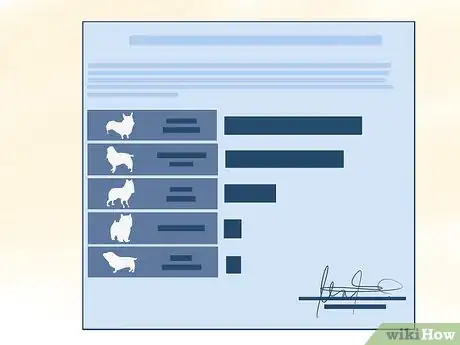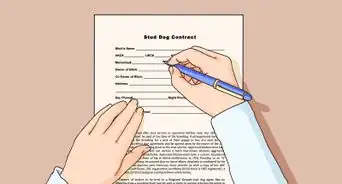This article was co-authored by wikiHow Staff. Our trained team of editors and researchers validate articles for accuracy and comprehensiveness. wikiHow's Content Management Team carefully monitors the work from our editorial staff to ensure that each article is backed by trusted research and meets our high quality standards.
This article has been viewed 20,333 times.
Learn more...
Testing your dog’s DNA can help you keep track of your dog as well as figure out ancestry and parentage. If you have a new dog, it is a good idea to get a DNA profile. The DNA profile will help determine identity in the event that your dog is lost. If you have a mixed breed dog and have always wondered about its ancestry, a DNA test can help you figure this out. And if you want to figure out who is the father or mother of your dog, a DNA paternity test will be useful.
Steps
Ordering a DNA Test
-
1Look for a reputable laboratory. Start by asking your veterinarian about the most appropriate laboratory to obtain the test you want. Two of the bigger companies that offer DNA testing are Wisdom Panel and DNA My Dog. Consider asking your veterinarian which laboratories are the most reputable and whether there are significant differences in price. Ask them:
- “What is the best laboratory to test my dog’s DNA?”
- “How many laboratories offer these tests in our region?”
- “What are the cost differences between the competing laboratories?”
- “Are there any major differences in customer service between the laboratories?”
-
2Weigh the cost. DNA tests can vary in cost depending on what you're testing for and where you're having the test done. If you are shopping around, consider both the price of the actual DNA test and any additional costs involved in transporting the DNA sample and following up with a veterinarian at the lab. If the price difference between laboratories is small, you should also consider whether or not it is worth spending a little more and whether there are any associated differences in expertise or service.[1]Advertisement
-
3Select a type of test. If you are a dog owner or a breeder, you may want to determine the parentage of your dog, and you may also want to figure out the ancestry of your dog. Ask your veterinarian to order the particular type of test that you'd like. Alternately, visit a laboratory in person or online to order the test directly from a laboratory that specializes in dog DNA.
- For a DNA parentage test, a lab will charge a fee per sample so you will be paying more or less depending on how many samples you need tested. You will need to have access to your dog, as well as the mother and father dogs that you want tested for parentage. The test will tell you whether there is a match between your dog and the possible mother and father dogs.
- You can also order a DNA parentage test for an entire litter of dogs. If you are managing a lot of dogs, this will give you confidence that all of the puppies belong to the same parents.[2]
- Laboratories sometimes offer a DNA test to determine if there is any wolf or coyote DNA in your dog. This is often a separate test.
-
4Order a dog DNA profile. Ask your veterinarian to help you order a DNA profile for your dog. Getting a DNA profile of your dog is a highly secure way of identifying your dog in the event of loss or illness. If your dog is ever lost, the profile will be invaluable as a way of ensuring any dog you find is actually your dog. In the event of illness, your dog’s DNA profile will also be crucial for determining that the correct sample is being used to test your dog for particular diseases. You can order DNA profiles from a variety of laboratories, which your veterinarian will know.
- In addition to the DNA profile, it is worthwhile microchipping your dog. Although your dog’s DNA profile is the most fool proof way of identifying your dog in the event of loss, the microchip will be the faster method. Ask your veterinarian to insert a microchip between your dog’s collarbones.[3]
- Once you have figured out your dog’s DNA profile, you should get it stored at the laboratory and at your veterinary office. If your dog gets sick or lost, the DNA profile will be very useful.
Collecting the Sample
-
1Collect a sample of your dog’s DNA for the ancestry test. You can collect the sample yourself using the DNA test kit. The swab will come in a collection tube. Using the swab included in your DNA test, take a swab from inside your dog’s cheek. Rub it on the inside of your dog’s cheek and underneath their tongue for sixty seconds. Take it out and put it in the collection tube.[4]
-
2Collect the DNA samples for the parentage test. You can collect the sample yourself but it will help to have your veterinarian direct the process. You will need to use a swab to collect DNA samples from the puppy, mother and father. If the puppy has been feeding from the mother, you will need to separate them for a few minutes before taking the swab to avoid sending milk to the lab. You should collect one sample at a time and write the names of the dogs on the sample tubes.[5]
-
3Ask your veterinarian to collect a sample of your dog’s DNA. If you feel unsure about how to collect a sample of your dog’s DNA, you could ask your veterinarian. Tell them you want to collect your dog’s DNA for a laboratory test to determine parentage, ancestry or DNA profile.
- If you ordered a test, you should bring the entire test kit to the veterinarian so they will have all of the details.
-
4Send the sample of your dog’s DNA to the laboratory. Using the address given to you by the company, mail your DNA sample back to the laboratory. Once the company receives your dog’s DNA sample, it will probably take them a few weeks to analyze it. Phone them to find out the processing time for your sample.[6]
- You can also get your veterinarian to send the sample to the laboratory.
Interpreting the Results
-
1Review the results of the parentage analysis. Review the details of the parentage profile summary including with relation to DNA markers, matches, and inclusion or exclusion of possible parents. Figure out whether the test has positively identified specific parents as a DNA match and whether any dogs have been excluded as possible parents.
- If you are testing for multiple fathers, you will probably find a complete DNA match for only one father. This will ensure you know the correct father or sire of the dog.
- If neither parent is a match, you will have to do another DNA test.
-
2Review your results of the ancestry analysis. Look at the results of your dog’s DNA test analysis. Depending on the DNA test you ordered, these results may include information on the specific breeds in your dog’s ancestry, as well as information on types of breeds and fitness levels.[7]
- Reflect on the relationship between the laboratory analysis and what you thought your dog’s ancestry might be. Consider whether you are surprised or whether the results confirmed your suspicions with regards to the specific breeds in your dog’s ancestry.
-
3Talk to the laboratory about the results. To further understand your dog’s DNA test results, it can help to phone the laboratory and talk to one of the veterinarians. They may be able to give you some further insight into the results of your dog’s DNA test, especially if there is anything surprising about the results. You can also bring the results to your vet to see if they can clarify any questions or provide further explanation.[8]
Community Q&A
-
QuestionHow do I interpret the results?
 Community AnswerThe company that sells and processes the test will send you the results. If it's an AKC test, parentage is determined by percentages. A DNA test for a dog does not tell you who their parents are.
Community AnswerThe company that sells and processes the test will send you the results. If it's an AKC test, parentage is determined by percentages. A DNA test for a dog does not tell you who their parents are. -
QuestionAre black pugs longer than the fawn colored ones?
 LinnieTop AnswererNo, black pugs and fawn pugs should be about the same size since they are the same breed.
LinnieTop AnswererNo, black pugs and fawn pugs should be about the same size since they are the same breed. -
QuestionMy Pembroke male is much bigger than my female. Is that normal?
 LinnieTop AnswererBoth male and female Pembroke Welsh corgis are around 10-12 inches (25.4-30.48 centimeters) tall; however, male Pembrokes weigh roughly 30 pounds (14 kilograms), while females usually weigh 28 pounds (13 kilograms). It is possible that the male may be overweight, the female underweight, or both dogs perfectly healthy but unusually small or large.
LinnieTop AnswererBoth male and female Pembroke Welsh corgis are around 10-12 inches (25.4-30.48 centimeters) tall; however, male Pembrokes weigh roughly 30 pounds (14 kilograms), while females usually weigh 28 pounds (13 kilograms). It is possible that the male may be overweight, the female underweight, or both dogs perfectly healthy but unusually small or large.
References
- ↑ http://fortune.com/2015/06/25/dog-dna-tests/
- ↑ http://www.akc.org/dna/
- ↑ https://www.petlog.org.uk/
- ↑ https://embarkvet.com/how-to-swab
- ↑ https://vetdnacenter.com/dna-tests/canine-dna-testing/canine-parentage-testing/
- ↑ http://fortune.com/2015/06/25/dog-dna-tests/
- ↑ http://fortune.com/2015/06/25/dog-dna-tests/
- ↑ http://fortune.com/2015/06/25/dog-dna-tests/
- ↑ http://www.akc.org/dna/
About This Article
To get your dog’s DNA tested, start by asking your vet to recommend a reputable lab. Some popular options include Wisdom Panel and DNA My Dog. Once you have a few options to look at, compare each lab’s costs for the kinds of tests that you are interested in getting. For example, you might want to get a parentage test for just one dog or an entire litter, or you may want to test for other factors, such as whether your dog as wolf or coyote ancestry. You can also talk to your vet about getting a full DNA profile for your dog, which can help you track your dog if it gets lost and is also helpful for finding out if your dog is at risk for certain health problems. Scroll down for more advice, including how to collect a DNA sample from your dog!



